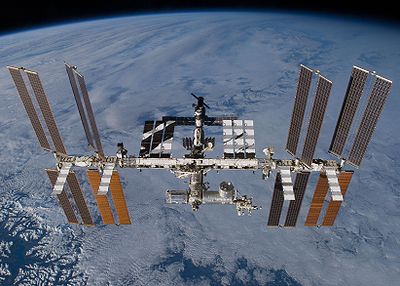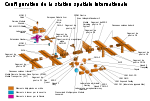US Orbital Segment
- US Orbital Segment
-

L'USOS est constitué de tous les modules situés du côté du
PMA-1
United States Orbital Segment (USOS) qui signifie "segment orbital américain" est le nom donné à la partie de la station spatiale internationale (ISS) construite et exploitée par la NASA américaine, l'Agence spatiale européenne (ESA), l'Agence spatiale canadienne et l'Agence d'exploration aérospatiale japonaise.
Le segment est actuellement composé de huit modules pressurisés (Unity (Node 1), Harmony (Node 2), Tranquility (Node 3), Destiny, Columbus, Kibō, Quest, et Cupola), de la poutre et de divers éléments non pressurisés qui reprennent une partie de la configuration de la station spatiale Freedom, annulée et incluse dans l'ISS. Le secteur est contrôlé à partir de centres de contrôle de mission différents répartis dans le monde entier, incluant le MCC-H (Mission Control Center (NASA)), le Col-CC (Columbus Control Center), l'ATV-CC (ATV Control Center), le JEM-CC (JEM Control Center), l'HTV-CC (HTV Control Center ) et le CC-MSS (Control Center-Mobile Servicing System, « Mobile Servicing System » désignant le bras télémanipulateur Canadarm 2).
Références
Voir aussi
v · Programme spatial américain |
| Lanceurs |
Ares (I, V) · Athena · Atlas (I, II, III,V) · Delta (II,III,IV) · Falcon 1,5,9 · Juno I,II · Minotaur · Pegasus · Saturn (Saturn I, IB, V, INT-21) · SLS · Taurus, II · Thor (Agena, Burner) · Scout · Titan (II, III, IIIB, 34D, IV) · Vanguard |
| Missions habitées |
Mercury (1961-1963) · Gemini (1965-1966) · Apollo (1967-1975) · Skylab (1973-1974) · Navette spatiale (1981-2011) · Station spatiale internationale (1998-) · Constellation |
| Exploration du système solaire |
Pioneer¹ (1958-1978) · Ranger¹ (1961-1965) · Mariner¹ ( 1962-1973) · Surveyor¹ (1966-1968) · Viking¹ (1975) · Voyager¹ (1977) · ICE (1978) · Galileo (1989) · Magellan (1989) · Mars Observer (1992) · Near (1996) · Mars Global Surveyor (1996) · Mars Pathfinder (1996) · Cassini-Huygens ²(1997) · Mars Climate Orbiter (1998) · Deep Space (1998) · Stardust (1999) · Mars Polar Lander (2000) · 2001 Mars Odyssey (2001) · CONTOUR (2002) · Mars Exploration Rover¹ (Spirit) (2003) · Deep Impact (2004) · MESSENGER (2004) · Mars Reconnaissance Orbiter (2005) · New Horizons (2006) · Phoenix (2007) · Dawn (2007) · Lunar Reconnaissance Orbiter (2009) · LCROSS (2009) · Mars Science Laboratory (2011) · Juno (2011) · GRAIL (2011) · MAVEN (2013) · LADEE (2013) · Venus In-Situ Explorer (2013) · Solar sentinels¹ (2015) - OSIRIS-REx (2016) - Jupiter Europa Orbiter² (2020) |
| Satellites |
|
| Centres de lancement |
Centre spatial Kennedy · Cap Canaveral · Vandenberg · Wallops Island · Kodiak Launch Complex · Mars · Spaceport America · Ronald Reagan Test Site |
| Établissements de la NASA |
NASA · Lyndon B. Johnson · Langley · Marshall · Dryden Flight Research Center · JPL · Ames · Glenn · Goddard · John C. Stennis · Michoud · White Sands · Deep Space Network |
| Histoire - programmes |
Programme Explorer (1959-) · Programme Lunar Precursor Robotic (en cours) · Programme Flagship (en cours) · Programme Discovery (en cours) · Programme Mars Scout (en cours) · Programme New Frontiers (en cours) · Projet Constellation (en cours) · Programme Earth Observing System (1997-) · Vision for Space Exploration (2004) · NMP (1998-2006) · ESE · Grands observatoires · Innovative Interstellar Explorer · Planetary Grand Tour · Planetary Observer program · SERT · Hitchhiker Program (1984) · NACA (1915-1958) |
| Voir aussi |
X-15 X-33
Les articles rangés dans les catégories NASA , Astronaute américain, Programme spatial américain,
Les autres agences spatiales américaines : DoD, NRO, NGA, NOAA |
| Les dates sont celles du lancement ¹ Programme ou plusieurs satellites ou sondes ²Satellite ou programme international |
Wikimedia Foundation.
2010.
Contenu soumis à la licence CC-BY-SA. Source : Article US Orbital Segment de Wikipédia en français (auteurs)
Regardez d'autres dictionnaires:
Russian Orbital Segment — Le ROS vu pendant l EVA3 de la mission STS 129 … Wikipédia en Français
Orbital Piloted Assembly and Experiment Complex — (OPSEK, en français : complexe expérimental et assemblage orbital piloté) est le successeur russe prévu à la Station spatiale internationale, avec l objectif principal de soutenir l exploration spatiale[1]. Sommaire 1 Vue d ensemble 2 … Wikipédia en Français
Orbital Piloted Assembly and Experiment Complex — CG rendering of OPSEK The Orbital Piloted Assembly and Experiment Complex (Orbitalniy Pilotiruemyi Eksperimentalniy Kompleks[1]) (OPSEK) is the planned Russian successor to the International Space Station, with the main goal of supporting deep… … Wikipedia
Segmento orbital ruso — El segmento tal y como estaba durante la EVA3 de la misión STS 129 … Wikipedia Español
International Space Station — ISS redirects here. For other uses, see ISS (disambiguation). International Space Station … Wikipedia
International Space Station program — The International Space Station program is tied together by a complex set of legal, political and financial agreements between the fifteen nations involved in the project, governing ownership of the various components, rights to crewing and… … Wikipedia
Space station — The International Space Station in May 2011 A space station (or orbital station) is a spacecraft capable of supporting a crew which is designed to remain in space (most commonly in low Earth orbit) for an extended period of time, and to which… … Wikipedia
Node Module — redirects here. For other uses, see Node Module (disambiguation). The Node Module (NM) is a pressurized module of the Russian Segment (RS or ROS) of the International Space Station (ISS) and will be used in the OPSEK space station. NM is being… … Wikipedia
Poisk (ISS module) — Poisk docking module at the Space Station. Poisk (Russian: Поиск; lit. Search), also known as the Mini Research Module 2 (MRM 2), Малый исследовательский модуль 2, or МИМ 2, is a docking module of the International Space Station. Its original… … Wikipedia
Zvezda (ISS module) — For other uses, see Zvezda (disambiguation). ISS Zvezda The Zvezda service module of the ISS with Zarya to the right and a docked Soyuz spacecraft to the left … Wikipedia
 L'USOS est constitué de tous les modules situés du côté du PMA-1
L'USOS est constitué de tous les modules situés du côté du PMA-1

